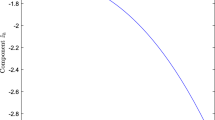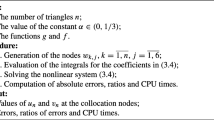Abstract
We consider the direct boundary integral equation formulation for the mixed Dirichlet–Neumann boundary value problem for the Laplace equation on a plane domain with a polygonal boundary. The resulting system of integral equations is solved by a collocation method which uses a mesh grading transformation and trigonometric polynomials. The mesh grading transformation method yields fast convergence of the collocation solution by smoothing the singularities of the exact solution. Special care is taken for handling the hypersingular operator as in Hartmann and Stephan (in: Dick, Kuo, Wozniakowski (eds) Festschrift for the 80th birthday of Ian Sloan, Springer, Berlin, 2018). With the indirect method used in Elschner et al. (Numer Math 76(3):355–381, 1997) this was avoided. Using Mellin transformation techniques a stability and solvability analysis of the transformed integral equations can be performed, in a setting in which each arc of the polygon has associated with it a periodic Sobolev space.

Similar content being viewed by others
References
Atkinson, K.E., Sloan, I.H.: The numerical solution of first-kind logarithmic-kernel integral equations on smooth open arcs. Math. Comput. 56, 119–139 (1991)
Chandler, G.A., Graham, I.G.: Product integration-collocation methods for noncompact integral operator equations. Math. Comput. 50, 125–138 (1988)
Costabel, M., Stephan, E.P.: The method of Mellin transformation for boundary integral equations on curves with corners. In: 5th IMACS Conference, Lehigh Univ. Computer methods for Cauchy singular integral equations (1984)
Costabel, M., Stephan, E.P.: Boundary Integral Equations for Mixed Boundary Value Problems in Polygonal Domains and Galerkin Approximation. Mathematical Models and Methods in Mechanics, vol. 15, pp. 175–251. Banach Center Publications, PWN-Polish-Scientific Publishers, Warsaw (1985)
Elschner, J., Graham, I.G.: An optimal order collocation method for first kind boundary integral equations on polygons. Numer. Math. 70, 1–31 (1995)
Elschner, J., Graham, I.G.: Numerical methods for integral equations of Mellin type. J. Comput. Appl. Math. 125, 423–437 (2000)
Elschner, J., Jeon, Y., Sloan, I.H., Stephan, E.P.: The collocation method for mixed boundary value problems on domains with curved polygonal boundaries. Numer. Math. 76(3), 355–381 (1997)
Elschner, J., Stephan, E.P.: A discrete collocation method for Symm’s integral equation on curves with corners. J. Comput. Appl. Math. 75, 131–146 (1996)
Hartmann, T., Stephan, E.P.: A discrete collocation method for a hypersingular integral equation on curves with cornes. In: Dick, J., Kuo, E.Y., Wozniakowski, H. (eds.) Festschrift for the 80th Birthday of Ian Sloan. Springer, Berlin (2018)
Jeon, Y., Sloan, I.H., Stephan, E.P., Elschner, J.: Discrete qualocation methods for logarithmic-kernel intregral equations on a piecewise smooth boundary. Adv. Comput. Math. 7, 547–571 (1997)
Kress, R.: A Nyström method for boundary integral equations on domains with corners. Numer. Math. 58, 145–161 (1990)
Mikhlin, S.G., Prößdorf, S.: Singular Integral Operators. Springer, Berlin (1986)
Prößdorf, S., Silbermann, B.: Numerical Analysis for Integral and Related Operator Equations. Operator Theory, vol. 52. Birkhäuser, Basel-Stuttgart (1991)
Yan, Y., Sloan, I.H.: On integral equations of the first kind with logarithmic kernels. J. Integr. Equ. Appl. 1(4), 549–579 (1988)
Author information
Authors and Affiliations
Corresponding author
Additional information
Dedicated to Prof. Dr. Wolfgang L. Wendland on the occasion of his 80th birthday.
Appendix
Appendix
Here we list some results on Mellin convolution operators (see [5, 7] and [3]).
-
(i)
The Mellin transform \(\widehat{v}\) of a function \(v:\mathbb {R}^{+}\rightarrow \mathbb {C}\) is defined as:
$$\begin{aligned} \widehat{v}(z)=\int _0^{\infty }x^{iz-1}v(x)dx. \end{aligned}$$The operator \(v\rightarrow \widehat{v}\) is an isomorphism from \(\widetilde{H}^s(\mathbb {R}^{+})\) into the completion of \(C^{\infty }(\mathfrak {I}z=s-1/2)\) under the norm
$$\begin{aligned} \left( \int _{\mathfrak {I}z=s-1/2}(1+|z|^2)^s|\widehat{v}(z)|^2 |dz|\right) ^{1/2}. \end{aligned}$$The inverse to \(v\rightarrow \widehat{v}\) is given by
$$\begin{aligned} v(x)=\frac{1}{2\pi }\int _{\mathfrak {I}z=-1/2}x^{-iz}\widehat{v}(z)|dz|. \end{aligned}$$For \(v\in C_0^{\infty }(\mathbb {R}^{+})\), \(\widehat{v}\) is analytic on \(\mathbb {C}\).
-
(ii)
Let \(\mathcal{K}\) be a Mellin convolution operator, i.e. \(\mathcal{K}\) has the form
$$\begin{aligned} \mathcal{K}v(x)=\int _0^{\infty }K\left( \frac{x}{y}\right) \frac{v(y)}{y}dy. \end{aligned}$$(129)with kernel K and symbol
$$\begin{aligned} \widehat{\mathcal{K}}(z)=\text{ symbol }(\mathcal{K})=\widehat{K}(z). \end{aligned}$$If \(x^{-1/2}K(x)\in L_1(\mathbb {R}^+)\), then \(\widehat{\mathcal{K}v}(z)=\widehat{\mathcal{K}}(z) \widehat{v}(z)\), and \(\mathcal{K}\) is a continuous operator on \(L_2(\mathbb {R}^+)\) with norm bounded by
$$\begin{aligned} ||\mathcal{K}||_0\le \sup _{\mathfrak {I}z=-1/2}|\widehat{\mathcal{K}}(z)|. \end{aligned}$$(130) -
(iii)
If \(\mathcal{K}\) and \(\mathcal{L}\) are Mellin convolution operators with bounded symbols on \(\mathfrak {I}z=-1/2\), then \(\mathcal{K}\mathcal{L}\) is a Mellin operator with bounded symbol \(\widehat{\mathcal{K}\mathcal{L}}=\widehat{\mathcal{K}}\cdot \widehat{\mathcal{L}}\).
If \(|\widehat{\mathcal{K}}|\ge c>0,\,\mathfrak {I}z=-1/2\), then \(\mathcal{K}\) continuously invertible on \(L_2(\mathbb {R}^{+})\), where its inverse is again a Mellin operator with symbol \(\widehat{\mathcal{K}^{-1}}=(\widehat{\mathcal{K}})^{-1}\).
-
(iv)
The symbol \(\widehat{\mathcal{K}}(z)\) of a Mellin convolution operator \(\mathcal{K}\) is said to be from the class \(\sum _{\alpha ,\beta }^{-\infty }\), \(\alpha<-1/2<\beta \), if it is analytic in the strip \(\alpha<\mathfrak {I}z<\beta \) and the estimates
$$\begin{aligned} \widehat{\mathcal{K}}(z)=\mathcal{O}((1+|z|)^{-k}),\,|z|\rightarrow \infty ,\,k\in \mathbb {N}, \end{aligned}$$hold in each substrip \(\alpha '<\mathfrak {I}z<\beta ',\,\alpha<\alpha '<1/2<\beta <\beta '\). Then the kernel K of \(\mathcal{K}\) satisfies the estimates
$$\begin{aligned} \sup _{x\in \mathbb {R}^{+}}|x^{k-\rho }D^kK(x)|<\infty ,\,k\in \mathbb {Z}^{+},\,\alpha<\rho <\beta . \end{aligned}$$Especially for \(k=0\) this implies \(x^{-1/2}K(x)<cx^{\rho -1/2}\), such that \(x^{-1/2}K(x)\in L_1(\mathbb {R}^{+})\) (choose \(\rho >-1/2\) near 0, \(\rho <-1/2\) near \(\infty \)), and due to (ii) \(\mathcal{K}\) is then a bounded operator on \(L_2(\mathbb {R}^{+})\) with bound (130).
-
(v)
The Cauchy singular operator defined on \(\mathbb {R}^{+}\)
$$\begin{aligned} \mathcal{H}v(x)=\frac{1}{\pi }\,p.v.\int _0^{\infty }\frac{v(y)dy}{y-x} \end{aligned}$$is a Mellin operator with symbol \(\widehat{\mathcal{H}}(z)=-i\coth \pi z\), which is analytic for \(-1<\mathfrak {I}z<0\), and there holds
$$\begin{aligned} \widehat{\mathcal{H}}(z)=\mp i+\mathcal{O}((1+|z|)^{-k}),\,\mathfrak {I}z\rightarrow \pm \infty , \,k\in \mathbb {N}, \end{aligned}$$on each substrip \(\alpha '<\mathfrak {I}z<\beta ',\,0<\alpha '<1/2<\beta <1\). For the kernel \(H(x)=(1-x)^{-1}\) then (130) holds.
-
(vi)
Let \(\chi \) be a smooth functions with supp\((\chi )\subset [0, 1]\). If \(\widehat{\mathcal{K}}\in \sum _{\alpha ,\beta }^{-\infty }\) or \(\widehat{\mathcal{K}}(z)=-i\coth \pi z\) hold for Mellin convolution operator \(\mathcal{K}\), then the commutator \(\chi \mathcal{K}-\mathcal{K}\chi I\) is compact on \(L_2(\mathbb {R}^{+})\). If furthermore \(0\not \in \,\)supp\((\chi )\), then also \(\chi \mathcal{K}\) is compact on \(L_2(\mathbb {R}^{+})\).
-
(vii)
Let \(\phi \) and \(\phi _r,\,0<r<1,\) be the characteristic functions on the intervals (0, 1) and (r, 1). Assume there holds
-
1.
\(x^{-1/2}K(x)\in L_1(\mathbb {R}^{+})\),
-
2.
\(1+\widehat{\mathcal{K}}(-i/2+y)\ne 0,\,y\in \mathbb {R}\), and
-
3.
\(\{\text {arg}(1+\widehat{\mathcal{K}}(-i/2+y))\}_{-\infty }^{\infty }=0,\)
where {arg \(\cdot \}_{-\infty }^{\infty }\) denotes the change of the arguments , when y runs from \(-\infty \) to \(\infty \). Then the Mellin convolution operator \(\phi (I+\mathcal{K})\phi \) is continuously invertible on \(L_2(0,1)\), and the finite section operators \(\phi _r(I+\mathcal{K})\phi _r\) are stable, i.e. there exist a \(r_0>0\) and a \(c>0\), such that
$$\begin{aligned} ||\phi _r(I+\mathcal{K})\phi _r v||_0\ge c||\phi _r v||_0,\,v\in L_2(0,1), \end{aligned}$$for all \(r\le r_0\).
-
1.
-
(viii)
(Convolution theorem) For \( v \in C_{0}^{\infty }(0,\infty )\)
$$\begin{aligned} \mathcal{K}v(x)=\int _0^{\infty }K\left( \frac{x}{y}\right) x^{\alpha }y^{\beta } \frac{v(y)}{y}dy,\,\alpha ,\beta \in \mathbb {C}, \end{aligned}$$there holds
$$\begin{aligned} \widehat{\mathcal{K}v}(z)=\widehat{\mathcal{K}}(z-i\alpha )\widehat{v}(z-i(\alpha +\beta )). \end{aligned}$$
Rights and permissions
About this article
Cite this article
Stephan, E.P., Teltscher, M.T. Collocation with trigonometric polynomials for integral equations to the mixed boundary value problem. Numer. Math. 140, 153–190 (2018). https://doi.org/10.1007/s00211-018-0960-8
Received:
Revised:
Published:
Issue Date:
DOI: https://doi.org/10.1007/s00211-018-0960-8




